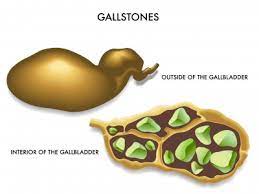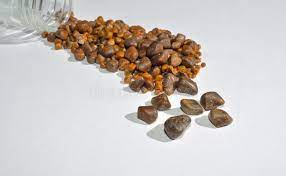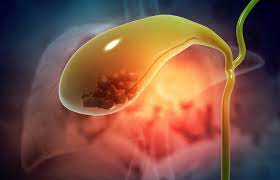Gallstone:
Gallstones are tiny hard lumps formed inside the gallbladder, a small organ below the liver. They arise when substances harden and build up in the bile, a digestive liquid produced by the liver. The stones can differ in size. Gallstones can cause pain or blockage when present in the gallbladder or bile ducts. This leads to various health problems. If they trigger symptoms or complications, gallstones may need medical treatment or removal.

Table of contents:
- Introduction
- Types
- Causes
- Sign and Symptoms
- What are diagnosis of gallstone?
- What are treatment and medications for gallstone?
. What is gallstone?

Definition:
The gallbladder is a tiny organ under the liver. Gallstones are solid masses formed in this storage organ. Bile, a fluid aiding fat digestion, gets stored here. These stones can consist of cholesterol, bilirubin, or both substances combined. The gallbladder’s main function is holding bile, which helps digest fats consumed.
Number of gallstones
Some individuals have just one gallstone. Others have many. If these stones block bile flow through the ducts, they cause pain or discomfort. This leads to gallbladder inflammation or complications.
. What are the main types of gallstones?

There are two main types of gallstones:
Cholesterol gallstone:
Cholesterol gallstones are stones that form when cholesterol becomes solid. They are the most common type of gallstone. These stones are yellow-green in color. They can be very small or big like golf balls.
Pigment gallstone:
Gallstones that are less common are composed of bilirubin, a waste product produced when red blood cells break down, as well as other substances. These gallstones typically appear as small, dark brown or black formations.
Other less common types of gallstones include:
- Mixed gallstones: Mixed gallstones have both cholesterol and bilirubin components.
- Calcium gallstones: Calcium gallstones, brown in hue, comprise calcium salts.
- Protein gallstones: Protein gallstones rarely occur, composed entirely of protein compounds.
.What are the main Causes of Gallstones?
Gallstones happen when too much cholesterol builds up in bile. Bile helps digest fat. If there’s lots of cholesterol, it can form crystals, which become gallstones over time. Several things cause excess cholesterol.
Other things that can cause gallstones include:
- Being overweight or obese
- Having a family history of gallstones
- Being over the age of 40
- Having pregnancy
- Having rapid weight loss
- Having certain medical conditions, such as diabetes or Crohn’s disease
- Taking certain medications, such as birth control pills
. What are the most common Symptoms of Gallstones?
Gallstone can result in a variety of symptoms, including:
- Biliary Colic
- Nausea and Vomiting
- Jaundice
- Fever and Chills
- Intolerance of Fatty Foods
- Steady Pain
- Back Pain
- Changes in Bowel Movements
What are the Diagnostic Tests for Gallstones?

The doctors often use an ultrasound to check for gallstone. For this test, sound waves create pictures of your gallbladder and bile ducts. If the ultrasound finds gallstones, your doctor may order more tests. These tests help understand your condition better.
- A diagnostic test involves taking some blood, to check for inflammation or infection signs.
- The HIDA scanning process examines how well the gallbladder carries out its functions.
- With an ERCP procedure, doctors can directly visualize and inspect the bile ducts alongside the gallbladder.
- MRCP or Magnetic resonance cholangiopancreatography provides detailed views. These depict bile ducts, gallbladder clearly. This imaging method utilizes magnetic resonance.
What are the Treatments of Gallstones?
For gallstone, treatment selection relies on symptom severity and complications present. Treatment options commonly utilized include:
Medications
Certain medications can dissolve small, cholesterol-based gallstone. These medications are taken orally and may take several months to work. are not effective for all types of gallstones and may cause side effects, so they are not commonly used.
Surgery
Removing gallstones usually involves surgery, particularly for people with severe symptoms or issues. There are two main surgical methods to treat gallstone.
- Laparoscopic cholecystectomy: In this minimally invasive procedure, surgeons create small incisions in the abdomen. They then utilize a camera and specialized tools to safely extract the gallbladder.
- Open cholecystectomy: A traditional operation removes your gallbladder. First, surgeons make a longer cut on your belly. This process might be needed if you have really bad swelling or scarring.
Endoscopic retrograde cholangiopancreatography (ERCP)
ERCP is a medical procedure employed to extract gallstones lodged within the bile ducts. This advanced technique involves the insertion of a slender and flexible tube through the mouth, guiding it further into the stomach and intestines. Once in position, the tube is effectively utilized to introduce a contrast dye into the bile ducts and successfully eliminate the troublesome gallstone.
Extracorporeal Shock Wave Lithotripsy (ESWL):
This method utilizes shock waves to fragment gallstone into smaller bits. Breaking them down makes it simpler for the stones to pass or get removed.
. What are the medications used for gallstones?
Medications commonly used for gallstones are:
| Medication | Usage | Mechanism of Action |
|---|---|---|
| Ursodiol (Actigall) | Used to dissolve cholesterol-based gallstone. | Reduces cholesterol production and promotes the breakdown of cholesterol in bile. |
| Chenodiol (Chenix) | Another option for dissolving cholesterol gallstone. | Similar to ursodiol, it helps dissolve cholesterol-based stones. |
| Rowachol | A complementary treatment to help dissolve gallstone. | Contains essential oils and bile acids to improve bile flow and dissolve small stones. |
. How painful is gallstone?
Gallstone pain often changes. It could be minor or sharp and intense. People usually feel cramping pain in the upper right belly. The pain might travel to the back or shoulder blade. Along with pain, a person may have nausea, vomiting, and bloating. The pain could continue for several hours.
. Home remedies to reduce the pain of gallstone
There are a few home remedies that may help to reduce the pain of gallstone:
- Apply a warm compress
- Drink peppermint tea
- Take a magnesium supplement
- Avoid fatty foods
- Eat small, frequent meals
- Get plenty of rest.
- Avoid strenuous activity
- Drink plenty of fluids to stay hydrated
- Avoid smoking and alcohol
- Maintain a healthy weight
. Note from Pharmacopathy:
The treatment of gallstones is tailored to the severity of symptoms and the specific type of gallstones. Common options include watchful waiting, medication, surgery, and ERCP. If you suspect having gallstones, it is crucial to seek medical attention for an accurate diagnosis and appropriate treatment.
For more detailed information about different diseases click on the link below…

Pingback: Peptic ulcer and their treatment - Pharmacopathy
Pingback: Cholangiocarcinoma: Complete Guide From Causes To Solution